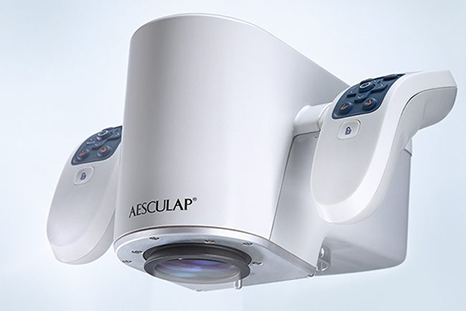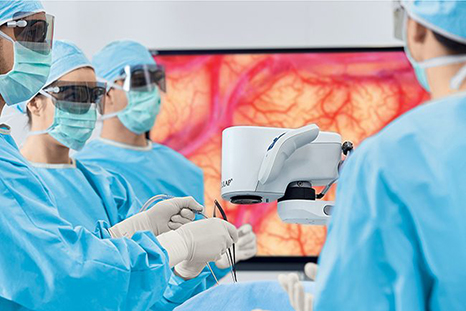
The Aesculap Aeos Robotic Digital Microscope from True Digital Surgery and Aesculap is now available in the United States. The system consists of a robotic arm and digital displays, and the company claims that it allows surgeons to achieve superior visualization compared with standard optical microscopes during a variety of complex surgical procedures.

The Aesculap Aeos includes software to help with visualization, including 3D digital visualization and a customizable Image Modes feature that allows the surgeon to augment what’s seen to better discern the tissue or structure of interest. A 10X optical zoom function and fluorescence backlighting also help with imaging.
In the midst of the pandemic, the system also provides surgeons with more protection, as the displays can be viewed by many staff members simultaneously and while wearing bulky PPE such as faceshields, unlike conventional surgical microscopes. The platform also avoids the need for surgeons to stoop or crouch unnaturally, and therefore helps them to prevent the back pain that is frequently associated with long hours spent performing surgery.
Medgadget had the opportunity to talk with True Digital Surgery Chairman and CEO Aidan Foley about the system.
Conn Hastings, Medgadget: Please give us a general overview of the system and its features.

Aidan Foley, True Digital Surgery: The Aesculap Aeos™ combines enhanced surgical visualization and precise robotic movement to provide neurosurgeons with stunning 3D views and a very efficient way of conducting surgery. One of the most relevant features is the heads-up video display, which helps to unify the surgical team by allowing everyone in the O.R. to see the procedure in 3D on a 4K resolution monitor. The TDS display also relieves ergonomic stress on the surgeon by removing the need to look into eyepieces that require him/her to move with the microscope. Aeos seamlessly integrates a digital microscope, fluorescence imaging, a six-degree-of-freedom robotic arm, and multiple means of remote control, all in one compact mobile cart. Additionally, robotic-assisted features that include location presets called WayPoints allow automated camera relocation to and from preset locations. The Lock-to-Target feature enables manual adjustment of the microscope position while maintaining focus on a surgical point of interest. Surgeons are also able to blend 3D surface views and sub-visible structures using Aeos’s advanced fluorescence imaging capability.
Medgadget: What are the advantages of a digital microscopy system compared with a traditional optical system?
Aidan Foley: The Aesculap Aeos overcomes critical limitations of traditional optical systems. First and foremost, Aeos digital microscopy leverages HDR image processing. This enhanced visual range increases the surgeon’s ability to simultaneously see both light and dark details which is critical to imaging deep cavities typical in brain surgery. Furthermore, the Aeos removes the need for the surgeon to look directly into the microscope oculars which can require the surgeon’s head to stay in very non-ergonomic positions and lead to long term back pain.
Medgadget: How does the system facilitate surgery in the context of the COVID-19 pandemic?

Aidan Foley: In the current COVID-19 environment, the use of personal protective equipment, or PPE can be crucial. This is another area where optical microscopes are at a disadvantage. While surgeons can’t wear face shields when using an optical microscope, the Aeos system allows them to do so without issue.
Medgadget: Surgeons can frequently experience back pain after a long day of surgery. How does the system help with surgical ergonomics?
Aidan Foley: Back pain has been an issue with surgeons for years, and is therefore a consideration among surgeons who use operating microscopes. The Aeos system is a game changer in this respect because it utilizes a heads-up display instead of traditional microscope oculars, freeing the surgeon to position his head in a comfortable and ergonomic position throughout the surgical procedure.
Medgadget: Please tell us about your collaboration with Aesculap, Inc.
Aidan Foley: Aesculap is a highly respected medical device company with a history dating back over 150 years. It’s a division of B. Braun, the renowned global organization founded in 1839. They are our distribution partner on a global basis for neurosurgery, ENT and spine. In addition, their longstanding relationships have provided input that has helped TDS refine many aspects of the Aeos system and will continue to do so for many years to come.
TDS’s novel image processing techniques enhance dynamic range, differentiate colors of clinical interest and improve adaptation to constantly-changing scene conditions. The combination of TDS’s expertise in digital image processing, robotics and display technology with Aesculap’s clinical experience has led to truly outstanding results. The 3D image on the Aeos heads-up 4K monitor display is useful in microsurgery which is evident by recent sales successes against large well-established surgical microscope players.
Medgadget: How will this latest launch in the US market help with increasing the reach and influence of the system?
Aidan Foley: The U.S. is clearly one of the largest medical device markets in the world, so we are obviously thrilled to be launching here.
In addition to its market size, the U.S. is also home to many key opinion leaders. Getting the support of these KOLs, based at established medical facilities as well as at teaching hospitals, will have a tremendous impact on earning market share. Our goal is to earn the trust of these respected professionals who wield significant influence on strategic advancements in surgical technology at their institutions.

Product page: Aesculap Aeos digital microscope
Links: True Digital Surgery and Aesculap…
